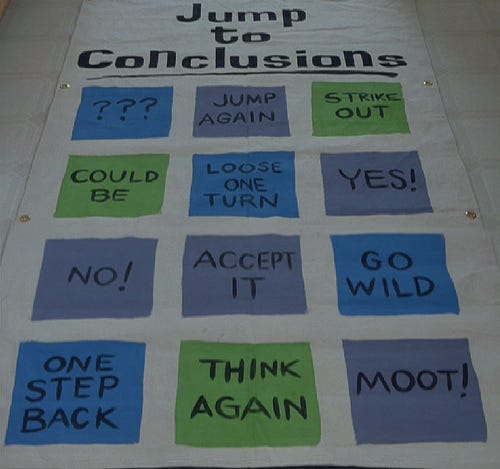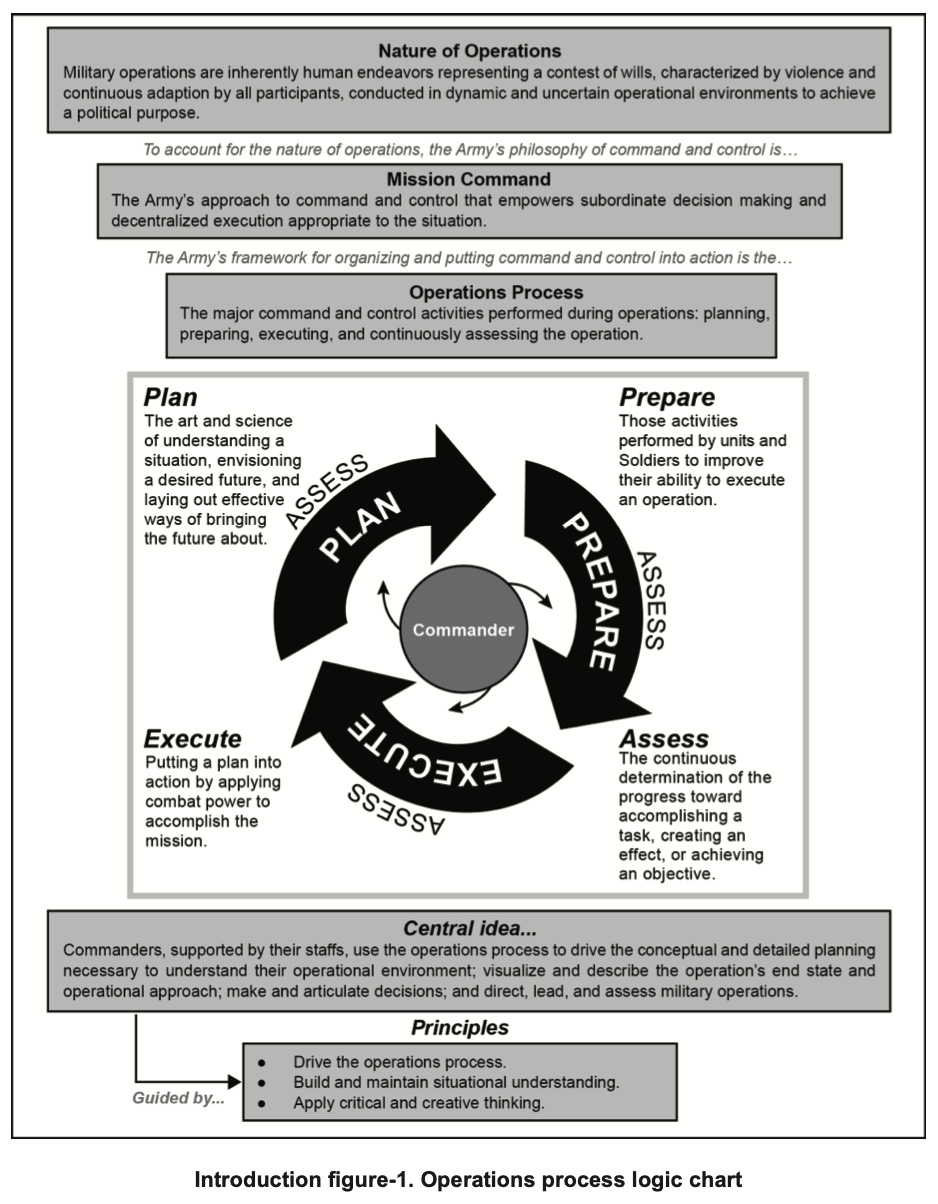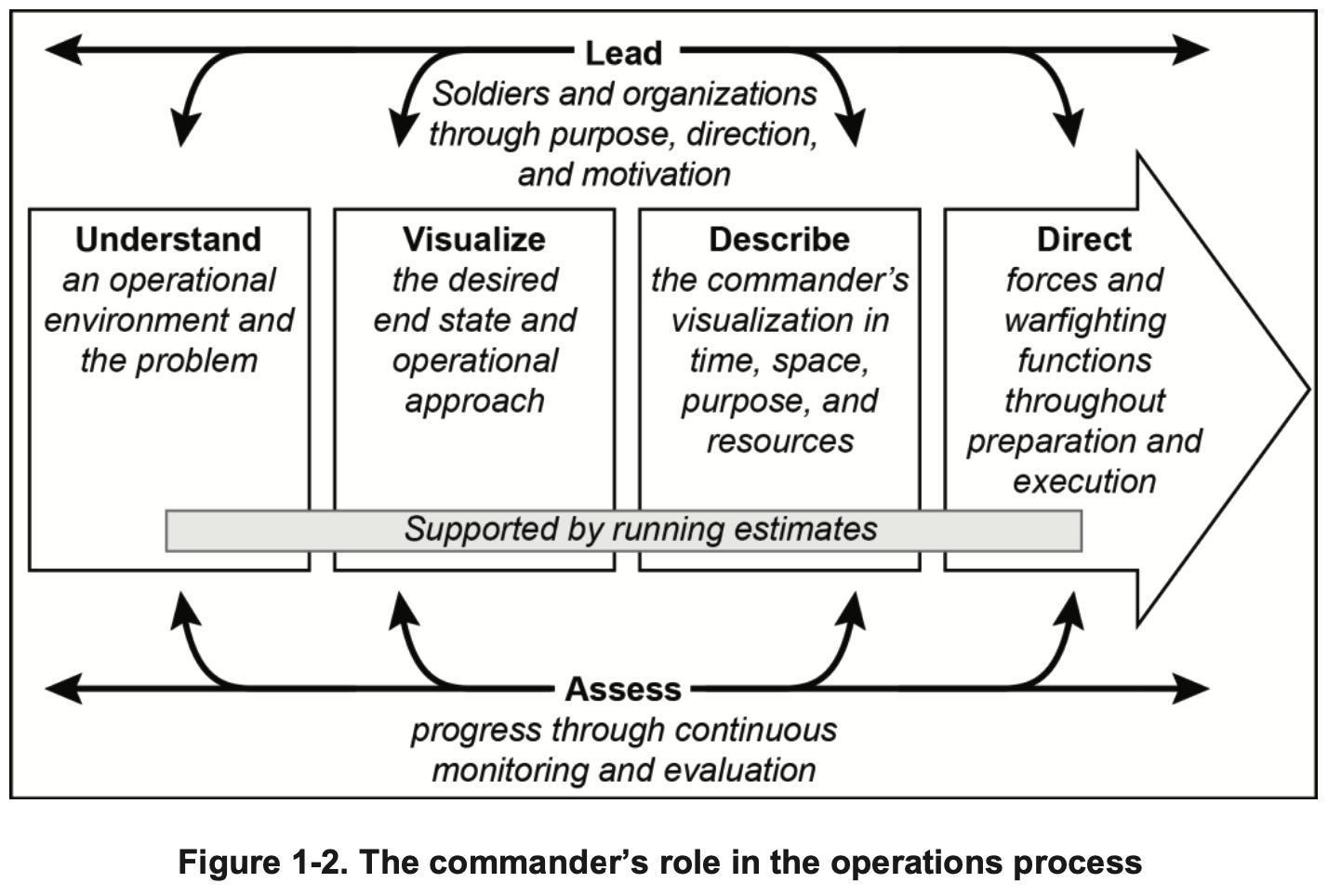
How deliberate are you, really?
Suggested Reading
ADP 5-0, The Operations Process
Pages 1-4 through 1-15 based on printed document (PDF pages 14-25)
An overview of the fundamentals and framework of the Operations Process
This week’s Study
Guided Discovery
How do you approach life? Are you deliberate? Or do you prefer to grab your gut and go?
If you’ve watched Office Space, you are familiar with Tom’s brilliant business idea, the “Jump to Conclusions” mat (if you have not seen Office Space, stop reading right now and go watch Office Space). It’s silly, but underscores a basic human tendency: the way we often respond to a task or topic is to just start responding. We jump to a conclusion and get to work.
Right now you might be telling yourself, “I’m fine being reactionary. I have great instincts, tons of experience, and I don’t need to waste time being deliberate.” There are plenty of minor activities in life for which this is appropriate.
As you progress up the life’s ladder of responsibility, the percentage of your time dedicated to minor activities continues to decrease, replaced by tasks and topics of true significance. When the outcome matters, can you afford to not be deliberate?
The United States Army feels very strongly about the Operations Process. It has its own Army Doctrine Publication (ADP). It is referenced, generally or specifically, in most other doctrines. It is “the framework for organizing and putting command and control into action…” Recall: no single activity is more important than command and control.
This is a lot of fine print, but let’s examine the critical process activities in which a leader must engage:
Planning
1-21. Planning is the art and science of understanding a situation, envisioning a desired future, and laying out effective ways of bringing that future about.
Preparation
1-22. Preparation consists of activities that units and Soldiers perform to improve their abilities to execute an operation. Preparation creates conditions that improve friendly forces’ opportunities for success. Activities of preparation help develop a shared understanding of the situation and requirements for execution.
Execution
1-23. Execution is putting a plan into action while using situational understanding to assess progress and adjust operations as the situation changes. Execution focuses on concerted action to seize and retain the initiative, build and maintain momentum, and exploit success.
Assessment
1-24. During planning, assessment focuses on gathering information to understand the current situation and developing an assessment plan. During preparation, assessment focuses on monitoring changes in the situation and on evaluating the progress of readiness to execute the operation. Assessment during execution involves a deliberate comparison of forecasted outcomes to actual events, using criterion to judge progress toward success.
The process feels intuitive, but it’s easier to say the process than to do it, and easier to do the process than to do it well. We’ll give them their own week of focus over the coming month.
One way to be deliberate is to have a process. Another way to be deliberate is be intentional in how you act as a leader within the execution of the process.
1-15. Commanders use the operations process to drive the conceptual and detailed planning necessary to understand their OE; visualize and describe the operation’s end state and operational approach; make and articulate decisions; and direct, lead, and assess operations as shown in figure 1-1.
The two blocks at center mass are the difference between being reactionary and being deliberate. Reactionary, go-with-your-gut actions jump from Understand to Direct (that’s jumping to a conclusion). A deliberate leader understands their full role in the operations process. Skipping visualization and description is where leaders lose their subordinates and decrease their leverage.
1-34. Collectively, this is known as commander’s visualization—the mental process of developing situational understanding, determining a desired end state, and envisioning an operational approach by which the force will achieve that end state.
Being deliberate in visualization is critical to being prepared to be describe the visualization to subordinates. Deliberateness is also thoroughness in the visualization. The text references the framework of how a military commander intends to organize their Area of Operations by various axis, including geography, purpose, and effort. The construct is useful for you too.
When you visualize outcomes and approaches, are you thorough, or do you focus on what you define as most critical? Are your definitions of criticality comprehensive or narrow?
Visualization, even when well done, is still bottlenecked in your brain until you describe it. And no, putting it in PowerPoint and emailing it is not describing it. Use your words.
1-37. Commanders describe their visualization to their staffs and subordinate commanders to facilitate shared understanding and purpose throughout the force. During planning, commanders ensure subordinates understand their visualization well enough to begin course of action (COA) development.
At least once in the last week you’ve left a meeting and immediately asked another attendee, “do you know what they actually want?”
How recently do you think people left a meeting you led and asked that about you? Recall: getting feedback is part of control. Seek it so you can clarify your descriptions.
The text provides three additional watch outs for leaders engaged in the Operations Process.
First, do not delegate the development of your critical thinking. Be deliberate in your approach to drafting your intent for an operation.
1-38. Commanders develop their intent statement personally. It must be easy to remember and clearly understood by commanders and staffs two echelons lower in the chain of command. The more concise the commander’s intent, the easier it is to understand and recall.
Second, appreciate that presence matters. Subordinates are paying attention to your personal style and interpret disorganized or disengaged demeanor as a lack of importance or thoughtfulness. Be deliberate in your presence.
1-47. Commanders lead by example through command presence. Command presence is creating a favorable impression in demeanor, appearance, and professional and personal conduct.
Third, be appropriately positioned. It is easy to get distracted by the next problem or the next operation. Being in command means being deliberate about where you are and where you are seen by subordinates so as to best guide, influence, and inspire.
1-48. Command occurs at the location of the commander. Where the commander locates within the AO is an important consideration for effective mission command.
Do you believe being deliberate is a differentiator?
How deliberately do you lead operations?
Questions for Individual Reflection
How does the Army's emphasis on situational understanding and visualization align with the strategic decision-making processes in large organizations? How might a business or team improve in these areas?
How can you create an operational framework that accounts for both the immediate (close) and long-term (deep) needs of your life? What challenges arise in balancing these two aspects?
The operations process advocates for continuous revision of plans in response to changing circumstances. How do you encourage flexibility in planning without creating confusion or lack of direction?
Professional Discussion Prompts
In business, what does "visualizing the future" look like? How does it differ from traditional forecasting methods, and how can we make this more actionable in strategic planning?
The concept of visualization in the operations process requires understanding the desired end state. How should we communicate and ensure alignment around long-term goals within our organization while maintaining day-to-day execution?
The operations process stresses the continuous need to assess progress and adjust accordingly. How can our company balance constant assessments with the need for decisive action, and how do we avoid analysis paralysis in our business operations?
Personal Discussion Prompts
How do you create a sense of shared understanding and purpose within your family or personal relationships? How does this influence how you make decisions together?
How do you ensure that your family or friends feel they have the necessary context and understanding when you're making decisions that impact them? What role does communication play in this process?
When have you used visualization techniques to frame desired end-states in your personal life? Who have you talked about these visualizations? If you have not, why not?
Exercises
Visualization
Exercise:
In teams, participants describe their organization’s end state in five years, using a visualization approach.
Discuss how this long-term visualization can help align day-to-day decisions.
Debrief:
How do you ensure alignment with this vision throughout your organization?
What barriers exist that prevent clear alignment to long-term goals?
Decentralized Decision-Making
Exercise:
Imagine a scenario where lower-level managers must make critical decisions without top-level approval.
Discuss the balance of empowering teams while maintaining strategic oversight.
Debrief:
How do you ensure alignment between decentralized decisions and corporate strategy?
What safeguards should be in place to prevent misalignment?
Feel free to borrow this with pride and use with your teams, professionally or personally. If you do, please let me know how it went and tips for improvement: matt @ borrowingwithpride.com






